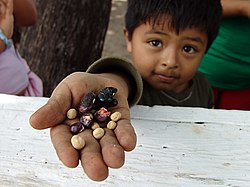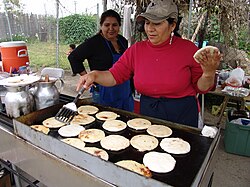South Central Farm
South Central Farm (also South Central Garden ) was an early example of contemporary urban horticulture in the district of South Central the US city of Los Angeles . The community garden was used by Latin American immigrants from 1994 to grow culturally typical foods and as a social meeting point. The police force eviction in 2006 was the subject of the 80-minute documentary The Garden by filmmaker Scott Hamilton Kennedy , which was released in 2008 and received an Oscar nomination for Best Documentary in 2009.
history
In 1986, the City of Los Angeles purchased 14 acres (5.7 hectares) within the city to build a waste incineration plant . This waste incineration plant was not realized after protests by the city population. In order to put the fallow land into use, the city granted the LA Regional Food Bank a revocable permit to build a community garden here. This offer was mainly used by Latin American immigrants who grew traditional Latin American vegetables and fruits on the premises. The journalist Jennifer Cockrall-King attributes the lively acceptance of this possibility by Latin American immigrants on the one hand to a still existing knowledge of cultivation methods as well as to the poor supply situation within this district. For nationally significant supermarket chains, the establishment of shops was unattractive due to the poor income situation of the local population in this district. Devon G. Pena, an anthropology professor at the University of Washington who studied the number of vegetables and fruits grown, found between 100 and 150 different types of plants grown here. Rottlieb Gottlieb, professor at the Urban and Environment Policy Institute in Los Angeles, rated the community garden as a successful example of ensuring inner-city food supplies and urban greening. However, the revaluation of the property meant that the original seller of the property invoked his right of repurchase documented in 1986, which was granted to him in the purchase agreement at the time. The city then sold the land back to the original owner without the knowledge of the users of the property.
The site evacuation began on the morning of June 13, 2006, when Los Angeles City police used chainsaws to demolish the garden fence. The gardens were leveled with bulldozers.
Rating
Journalist Jennifer cites South Central Farm as an example of an urban community garden that anticipated the move to support urban horticulture. The garden project ultimately failed because the recently immigrated garden users failed to gain sufficient political support. As a counterexample, she cites Fairview Gardens , the garden project in a suburb of Santa Barbara sponsored by the charismatic (and white) Michael Ableman , who managed to put this similar project under legal protection almost at the same time.
literature
- Jennifer Cockrall-King: Food and the City - Urban Agriculture and the New Food Revolution . Prometheus Books, New York 2012, ISBN 978-1-61614-459-3
Movie
- 2008: The Garden , documentary by Scott Hamilton Kennedy
Single receipts
- ↑ Jennifer Cockrall-King: Food and the City - Urban Agriculture and the New Food Revolution , p. 146
- ↑ Jennifer Cockrall-King: Food and the City - Urban Agriculture and the New Food Revolution , p. 147
- ↑ Jennifer Cockrall-King: Food and the City - Urban Agriculture and the New Food Revolution , p. 148
- ↑ Jennifer Cockrall-King: Food and the City - Urban Agriculture and the New Food Revolution , p. 149
- ↑ Jennifer Cockrall-King: Food and the City - Urban Agriculture and the New Food Revolution , p. 144
Coordinates: 34 ° 0 ′ 32.2 " N , 118 ° 14 ′ 28.4" W.



